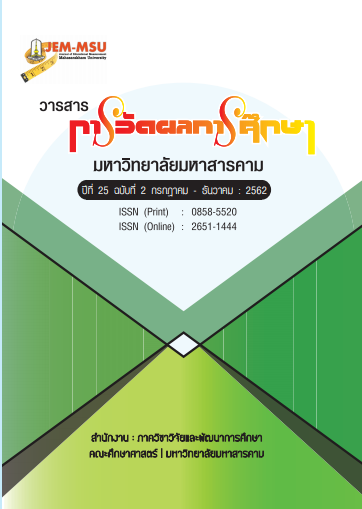Development of Mathematics Learning Activities by Using GeoGebra Program On Topic Sequences and Series for Grade 11 Students
Main Article Content
Abstract
The purposes of this study were to 1) develop learning activities using GeoGebra on the topic of Sequences and Series for grade 11 students to meet the efficiency criterion of 75/75, 2) study the effectiveness index of the learning activities using GeoGebra on the topic of Sequences and Series for grade 11 students, 3) compare the achievement of the students who learned with the learning activities using GeoGebra and the students who learned with the traditional learning activities, 4) study learning retention of the students who learned with the learning activities using GeoGebra and 5) study the satisfaction of the students who learned with the learning activities using GeoGebra. The sample consisted of 83 students from 2 classes in grade 11 of Buakhao School, Kuchinarai District, Kalasin Province, in the second semester of the academic year 2017, obtained through cluster random sampling; 43 students from Group 3 were in the experimental group while 40 students from Group 4 were in the control group. The instruments in this study comprised 18 plans of organizing learning activities using GeoGebra and 18 traditional plans of organizing learning activities. The allotted time for each plan was 1 hour; a 4-choice learning achievement test containing 30 items, with item difficulty (p) ranging from 0.54 to 0.76, item discrimination (B-index) ranging from 0.22 to 0.61, the total reliability of 0.86; and a questionnaire inquiring the satisfaction with the learning activities using GeoGebra, containing 20 questions, with item discrimination (rxy) ranging from 0.22 to 0.68 and the total reliability of 0.76. The statistics employed in the analysis of data were the arithmetic mean, percentage, standard deviation, E1/E2, E.I. The statistics used in hypothesis testing were t-test (independent samples) and t-test (dependent samples).
The results of this study were as follows:
1. The learning activities using GeoGebra on the topic of Sequences and Series for grade 11 students had the efficiency of 88.28/78.84 which passed the defined 75/75 efficiency criterion.
2. The effective index of the learning activities using GeoGebra on the topic of Sequences and Series for grade 11 students was 0.6408 or 64.08%
3. The students who learned with the learning activities using GeoGebra had the learning achievement higher than the students who learned with the traditional learning activities, with statistical significance at the .05 level.
4. The students who learned with the learning activities using GeoGebra on the topic of Sequences and Series for grade 11 students maintained their learning retention.
5. The students who learned with the learning activities using GeoGebra on the topic of Sequences and Series for grade 11 students, as a whole, were satisfied at a high level (= 4.37, SD = 0.58).
Article Details
The content and information contained in the published article in the Journal of Educational Measurement Mahasarakham University represent the opinions and responsibilities of the authors directly. The editorial board of the journal is not necessarily in agreement with or responsible for any of the content.
The articles, data, content, images, etc. that have been published in the Journal of Educational Measurement Mahasarakham University are copyrighted by the journal. If any individual or organization wishes to reproduce or perform any actions involving the entirety or any part of the content, they must obtain written permission from the Journal of Educational Measurement Mahasarakham University.
References
องค์การขนส่งสินค้าและพัสดุภัณฑ์.
ชยุตม์ ล้อธีรพันธ์. (2557). การเปรียบเทียบการใช้ โปรแกรม GSP กับโปรแกรม GeoGebraประกอบการ เรียนรู้เพื่อพัฒนาผลสัมฤทธิ์ทางการเรียนคณิตศาสตร์เรื่อง การแปลงทางเรขาคณิตของนักเรียนชั้น มัธยมศึกษาปีที่ 2. การประชุมวิชาการและนำเสนอผลงานวิจัยระดับชาติและนานาชาติ ครั้งที่ 6 (หน้า 137–145). กรุงเทพมหานคร: มหาวิทยาลัยราชภัฏสวนสุนันทา.
ดอกเกตุ ดวงโสมา. (2556). การพัฒนากิจกรรมการเรียนรู้คณิตศาสตร์ โดยใช้โปรแกรมจีเอสพี เรื่อง ฟังก์ชัน ตรีโกณมิติ สำหรับนักเรียนชั้นมัธยมศึกษาปีที่ 5. ปริญญาวิทยาศาสตรมหาบัณฑิต สาขาวิชาคณิต ศาสตรศึกษา คณะวิทยาศาสตร์ มหาวิทยาลัยมหาสารคาม.
นพดล อุณหศิริกุล. (2558). ผลการจัดกิจกรรมการเรียนรู้คณิตศาสตร์ โดยใช้โปรแกรม GeoGebra เรื่อง แคลคูลัสเบื้องต้น ที่มีต่อผลสัมฤทธิ์ทางการเรียนและความสามารถในการแก้ปัญหาทางคณิตศาสตร์ ของนักเรียนชั้นมัธยมศึกษาปีที่ 6 โรงเรียนตะกั่วป่า “เสนานุกูล.” การประชุมวิชาการระดับชาติ" มสธ วิจัย" ประจำปี 2559 (หน้า 914–920). สุโขทัย: มหาวิทยาลัยสุโขทัยธรรมาธิราช.
บุญชม ศรีสะอาด. (2553). การวิจัยเบื้องต้น ฉบับปรับปรุงใหม่. พิมพ์ครั้งที่ 10. กรุงเทพฯ: สุวีริยาสาส์น.
ประสาท เนืองเฉลิม. (2556). วิจัยการเรียนการสอน. พิมพ์ครั้งที่ 2. กรุงเทพมหานคร: สำนักพิมพ์แห่ง จุฬาลงกรณ์มหาวิทยาลัย.
ฟาฏินา วงศ์เลขา. (2553). การเรียนคณิตศาสตร์: ความจำเป็นที่ไม่ควรมองข้าม. [ออนไลน์]. Retrieved August 25, 2016, from https://social.obec.go.th/node/22
รัตน์ศญาณ์ดา ขันธุแสง. (2555). การพัฒนาการจัดกิจกรรมการเรียนรู้วิชาคณิตศาสตร์ เรื่อง ปริพันธ์ของ ฟังก์ชัน โดยใช้โปรแกรมจีเอสพี. ปริญญาวิทยาศาสตรมหาบัณฑิต สาขาวิชาคณิตศาสตรศึกษา คณะ วิทยาศาสตร์ มหาวิทยาลัยมหาสารคาม.
วิภาพร ทิพย์รักษา, ไพรินทร์ สุวรรณศรี. (2560). การศึกษาความเข้าและความคงทนในการเรียนรู้ เรื่อง พาราโบลา ของนักเรียนชั้นมัธยมศึกษาปีที่ 3 โดยจัดกิจกรรมการเรียนรู้ผ่านโปรแกรม GeoGebra. The 22nd Annual Meeting in Mathematics (AMM 2017) (หน้า 1– 8). Chiang Mai: Department of Mathematics, Faculty of Science, Chiang Mai University.
สถาบันส่งเสริมการสอนวิทยาศาสตร์และเทคโนโลยี. (2555). ครูคณิตศาสตร์มืออาชีพ เส้นทางสู่ความสำเร็จ. กรุงเทพมหานคร: 3 – คิว มีเดีย.
สุทิน บับภาวะตา. (2558). ผลของการใช้โปรแกรม GeoGebra ประกอบการจัดกิจกรรมการเรียนรู้ทาง คณิตศาสตร์ตามทฤษฎีคอนสตรัคติวิสต์ เรื่อง ความสัมพันธ์ระหว่างรูปเรขาคณิตสองมิติและสามมิติ ที่มีต่อผลสัมฤทธิ์ทางการเรียนของนักเรียนชั้นมัธยมศึกษาปีที่ 1 โรงเรียนนางรอง จังหวัดบุรีรัมย์. วารสารครุพิบูล, ฉบับพิเศษ, 50–61.
สุภชา เพ็ญจันทร์. (2555). การพัฒนาชุดกิจกรรมการเรียนรู้เรียนการสอนประกอบโปรแกรมจีเอสพี เรื่อง กำหนดการเชิงเส้น ของนักเรียนชั้นมัธยมศึกษาปีที่ 5. ปริญญาวิทยาศาสตรมหาบัณฑิต สาขาวิชา คณิตศาสตรศึกษา คณะวิทยาศาสตร์ มหาวิทยาลัยมหาสารคาม.
อธิภูมิ พาสงค์. (2560). การใช้โปรแกรม GeoGebra ประกอบการจัดกิจกรรมการเรียนรู้ตามรูปแบบ 4MAT เพื่อพัฒนาผลสัมฤทธิ์ทางการเรียนคณิตศาสตร์ เรื่อง แคลคูลัสเบื้องต้น สำหรับนักเรียนชั้น มัธยมศึกษาปีที่ 6. การประชุมวิชาการระดับชาติครุศาสตร์ ครั้งที่ 1 การจัดการศึกษาเพื่อพัฒนา ท้องถิ่น สูประชาคมอาเซียน : ทิศทางใหม่ในศตวรรษที่ 21 (457–466).
Arbain, N., & Shukor, N. A. (2015). The Effects of GeoGebra on Students Achievement. Procedia - Social and Behavioral Sciences, 172(2007), 208–214. https://doi.org/10. 1016/j.sbspro.2015.01.356
Hohenwarter, M., & et al. (2018). การนำซอฟต์แวร์คณิตศาสตร์เชิงพลวัตชั้นนำของโลกและสื่อการเรียนรู้ มามอบให้กับนักเรียนและครูทุกที่ทั่วโลก. Retrieved from https://www.geogebra.org/ about?ggbLang=th
Majerek, D. (2014). Application of Geogebra for Teaching Mathematics. Advances in Science and Technology Research Journal, 8(24), 51–54. https://doi.org/10.12913/22998624 /567
Preiner, J. (2008). Dynamic Mathematics Software to Mathematics Teachers : the Case of GeoGebra. Dissertation in Mathematics Education, Faculty of Natural Sciences, University of Salzburg.
Saha, R. A., Ayub, A. F. M., & Tarmizi, R. A. (2010). The effects of GeoGebra on mathematics achievement: Enlightening Coordinate Geometry learning. Procedia - Social and Behavioral Sciences, 8(5), 686–693. https://doi.org/10.1016/j.sbspro.2010.12.095
Shadaan, P., & Leong, K. E. (2013). Effectiveness of Using Geogebra on Students’ Understanding in Learning Circles. The Malaysian Online Journal of Educational Technology, 1(4), 1–11.


